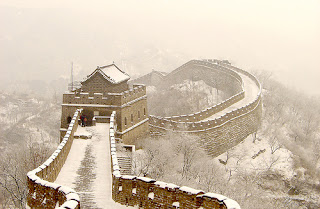 The Silk Road (also known as Silk Route), is one of the most famous ancient trade routes in the world. You might wonder where this name came about – it was in the 1870s when the geographer, Ferdinand von Richthofen, gave the name by which we now know as the Silk Road. Famous travellers such as Marco Polo, Zhang Qian, Ban Chao (班超, right), Fa Xian and Xuan Zang have travelled along the route while spreading their own religions and carrying out missions of utmost importance (e.g. Zhang Qian who was sent by Emperor Wu of Han Dynasty to seek alliance with the Yuezhis against the Xiongnus).
The Silk Road (also known as Silk Route), is one of the most famous ancient trade routes in the world. You might wonder where this name came about – it was in the 1870s when the geographer, Ferdinand von Richthofen, gave the name by which we now know as the Silk Road. Famous travellers such as Marco Polo, Zhang Qian, Ban Chao (班超, right), Fa Xian and Xuan Zang have travelled along the route while spreading their own religions and carrying out missions of utmost importance (e.g. Zhang Qian who was sent by Emperor Wu of Han Dynasty to seek alliance with the Yuezhis against the Xiongnus).
Interconnected with different ancient trade routes from various areas in Asia, the Silk Road is over 8000 kilometres (5000 miles) long! It stretches beyond lands to over oceans and seas. A prominent trading route, complete with merchants, traders, and even wanderers of different ancient civilizations relying greatly on it, the Silk is the main link between Asia, Europe and Africa (e.g. enabled Han Dynasty of China to reach out to the rest of the world). To think that a mere trading route would spread to the ends of the world!
 'Golden City' Lanzhou (兰州) - major stop on the ancient Silk Road
'Golden City' Lanzhou (兰州) - major stop on the ancient Silk Road
It mainly connects Asia Manor, the Mediterranean and Chang’an (now known as Xi’an), in China. No doubt, great civilizations of Rome, Egypt, China, Mesopotamia, Persia and Indian subcontinents had declared that the Silk was an important factor for their own development as they were able to take in new ideas from foreign countries. Since ancient times, Silk Road helped foundations all over this modern world to be laid. Today, the evidence of what the Silk has helped developed is of utmost prominence - ideas, religions and goods of foreigners are imprinted in particular countries.

The famous Jia Yu Guan (嘉峪关) - built by the First Emperor of China to protect China from the Xiongnu; which also greatly benefitted China's dynasties.

The Taklamakan Desert - largest desert in the world; hazardous yet full of treasures and secrets.
It is worth taking a trip to Silk Road because there are a lot of things to see along the road which you may never have seen before. All of the major attractions along the road makes it worth visiting. They include Dunhuang, Jiayuguan, Urumqi and Lanzhou. The Karakul Lake onwards from Kashgar has a very breathtaking and serene view that even the hottest tempers of humans would fade away - pictures are provided below. There is even a checkpoint in the mountains that people would not want to be turned away from after about 5 hours journey from Kashgar. Overall, Silk Road is a very unique place because of its amazing creation of mankind, a road that have connected the great civilizations of East and West, serving not only for trade, but also cultural, religious, technical and scientific exchanges of achievements. One can learn much when journeying the Silk - for the different types of people out there - with cultures and beliefs that even the wildest imaginations would never dwell on - might just pique your narrow minds.
 Dunhuang (敦煌) - sited at an oasis, and made a prefecture by Emperor Wu of Han
Dunhuang (敦煌) - sited at an oasis, and made a prefecture by Emperor Wu of Han
 A grass pasture of Urumqi, meaning 'beautiful pastures' - near the Urumqi River and Tianshan Mountains in Xinjiang, China
A grass pasture of Urumqi, meaning 'beautiful pastures' - near the Urumqi River and Tianshan Mountains in Xinjiang, China
 Greatest natural sight in Western China, the Karakul Lake - highest lake of the Pamir plateau, near the junction of the Pamir Mountains
Greatest natural sight in Western China, the Karakul Lake - highest lake of the Pamir plateau, near the junction of the Pamir Mountains












 Overhanging Wall of China in the Gansu Province near Jiayuguan - wintry scene.
Overhanging Wall of China in the Gansu Province near Jiayuguan - wintry scene.




 Dunhuang (敦煌) - sited at an oasis, and made a prefecture by Emperor Wu of Han
Dunhuang (敦煌) - sited at an oasis, and made a prefecture by Emperor Wu of Han
